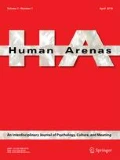Abstract
Western civilisation is generally presented as a journey from the world of many gods, to the world of one god, to the world of no god, i.e. from myth, to religion to science. This, we are told, is progress, the march of civilisation towards equality, hence Universal Human Rights, one that the rest of the world from Africa through India to China is expected to emulate. But is it? This paper asserts, but does not argue (for that would mean subscribing to the Western myth of one truth) that this view of the world is based on Western myth that tends to be universal, linear, singular, and objective-driven. There are other ways of seeing the world, shaped by different myths, the Indian myth, for example, that makes our worldview contextual, cyclical, plural and consequence-based (Pattanaik 2013a). Considering such non-Western worldviews will help the West realise how the West’s current conflict with immigrants is not modern, or unique, but timeless, an integral part of its worldview.
Similar content being viewed by others
Notes
Nina Paley’s blog is http://blog.ninapaley.com/
The official website is http://www.sitasingstheblues.com/
The official website is http://sedermasochism.com
Pattanaik (2013a) refers to ‘rana-bhoomi’ versus ‘ranga-bhoomi’
Mahāparinibbānasutta (in Davids 2000)
References
Ambedkar, B. R. (2011). The Buddha and his dhamma: a critical edition. Oxford University Press.
Brown, I. I. (1916). The sex worship and symbolism of primitive races. The Journal of Abnormal Psychology, 10(6), 418–432. https://doi.org/10.1037/h0073442.
Davids, T. W. R. (2000). Dialogues of the Buddha: translated from the Pali of the Dīgha Nikāya. Delhi: Motilal Banarsidass Publisher.
Dodd, K. V. (2016). Sita sings the blues. Journal of Religion & Film, 13(2), 16 Retrieved October 9, 2018, from https://digitalcommons.unomaha.edu/jrf/vol13/iss2/16/.
Doniger, W. (2011). God’s body, or, the lingam made flesh: conflicts over the representation of the sexual body of the Hindu god Shiva. Social Research, 78(2), 485–508.
Dunch, R. (2002). Beyond cultural imperialism: cultural theory, Christian missions, and global modernity. History and Theory, 41(3), 301–325.
Humphreys, C. (2005). Karma and rebirth: The karmic law of cause and effect. Routledge.
Inglehart, R. (2018). Culture shift in advanced industrial society. New Jersey: Princeton University Press.
Katz, S. (2018). ‘Seder-Masochism’: Why Is This Film Different from All Other Films? [Web log post]. Retrieved October 9, 2018, from https://www.awn.com/animationworld/seder-masochism-why-film-different-all-other-films
Kaufmann, Y. (1951). The bible and mythological polytheism. Journal of Biblical Literature, 179–197.
Kimmel, M. S. (2018). Peggy McIntosh: White privilege and male privilege: Peggy McIntosh. In M. S. Kimmel (Ed.), Privilege. A reader (pp. 42–54). London: Routledge.
Lodhia, S. (2015). Deconstructing Sitas blues: questions of mis/representation, cultural property, and feminist critique in Nina Paley’s Ramayana. Feminist Studies, 41(2), 371–408, 484–485. https://doi.org/10.15767/feministstudies.41.2.371.
McArthur, B. (1993). Your life: why it is the way it is and what you can do about it. Virginia Beach: ARE Press.
Mintzer, J. (2018). ‘Seder-Masochism’: Film Review | Annecy 2018 [Web log post]. Retrieved October 9, 2018, from https://www.hollywoodreporter.com/review/seder-masochism-review-1120073
Pattanaik, D., 2006. Myth= Mithya. Penguin Books India.
Pattanaik, D. (2013a). Business sutra: a very Indian approach to management. Aleph Book Company.
Pattanaik, D. (2013b). Sita: an illustrated retelling of the Ramayana. UK: Penguin (please see line 275).
Pattanaik, D. (2015). My Gita. Rupa Publications Pvt. Limited.
Pattanaik, D. (2016) Olympus. Random House India.
Pattanaik, D. (2018). Shyam: an illustrated retelling of the Bhagavata. Penguin Random House India Private Limited.
Robbins, E. (1860). Elements of mythology, or, classical fables of the Greeks and Romans: To which are added some notices of Syrian, Hindu, and Scandinavian superstitions, together with those of the American nations: the whole comparing polytheism with true religion: for the use of schools. Philadelphia: Moss, Brother & Company.
Sridharan, T. (2017). Transnational adaptation: the complex irreverence of narrative strategy in Nina Paley’s Sita sings the blues. Mediascape, UCLA’s Journal of Cinema and Media studies, Fall 2017. Retrieved October 9, 2018, from http://www.tft.ucla.edu/mediascape/Fall2014_TransnationalAdaptation.html
Tylor, E. B. (1871). Primitive culture: researches into the development of mythology, philosophy, religion, art, and custom. London: John Murray.
Author information
Authors and Affiliations
Corresponding author
Additional information
Some important source-content for the ideas showcased in this paper are from the following books by the author: i) Myth= Mithya, 2006, Penguin Books India; ii) Shiva to Shankara: Decoding the phallic symbol, 2006, Indus Source; and iii) The book of Ram, 2009, Penguin Books India.
Rights and permissions
About this article
Cite this article
Pattanaik, D. A Different Way of Seeing the World. Hu Arenas 1, 386–395 (2018). https://doi.org/10.1007/s42087-018-0041-7
Received:
Revised:
Accepted:
Published:
Issue Date:
DOI: https://doi.org/10.1007/s42087-018-0041-7




